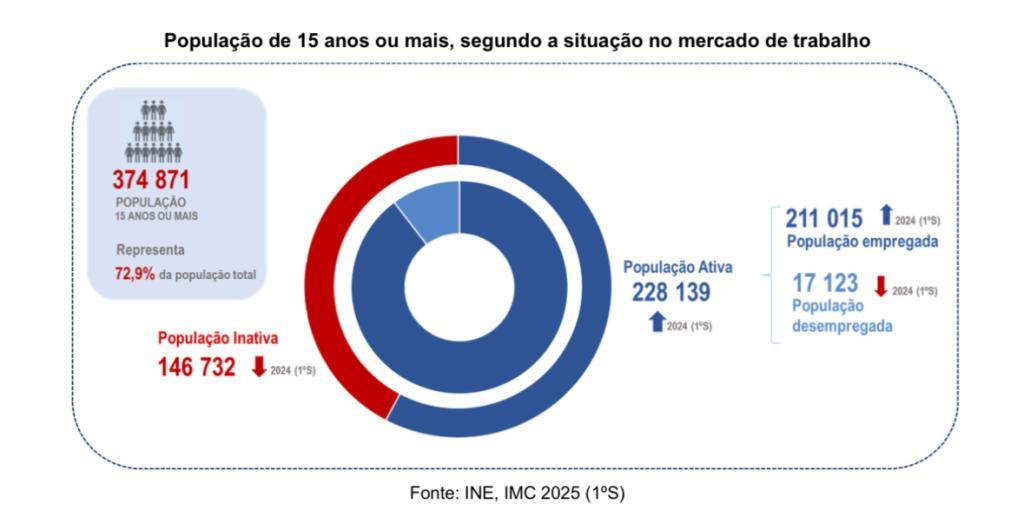Africa-Press – Cape verde. The unemployment rate fell to 7.5% in the first half of 2025, a reduction of 1.3 percentage points compared to the same period the previous year. According to data from the National Institute of Statistics (INE), the number of unemployed was estimated at 17,123 individuals, 10.1% fewer than in 2024.
According to the IBGE (Brazilian Institute of Geography and Statistics), the working-age population (15 years and older) was estimated at 374,871 individuals, corresponding to 72.9% of the total population.
Compared to the same period in 2024, the active population increased by 5.7% (+12,375 individuals), while the inactive population decreased by 5.6% (-8,694 individuals).
During the period under analysis, the economically active population was estimated at 228,139 individuals, representing an increase of approximately 14,300 compared to the same period in 2024. This increase was reflected in both genders, with the number of active women reaching 104,640 (+7,602), while the number of active men reached 123,499 (+4,773).
The activity rate was estimated at 60.9%, corresponding to an increase of 2.7 percentage points compared to the same period of the previous year. By gender, the IBGE (Brazilian Institute of Geography and Statistics) indicates that the activity rate was 67.0% for men and 54.9% for women, showing a difference of 12.1 percentage points between the two groups.
By municipality, Boa Vista and Sal stand out with the highest activity rates, respectively 79.1% and 77.8%, both above the national average. In contrast, the lowest values were recorded in São Miguel (31.5%) and São Salvador do Mundo (39.5%).
Employed Population
In the first half of 2025, the employed population was estimated at 211,015 individuals, corresponding to an employment rate of 56.3%. Compared to the same period in 2024, there was an increase of approximately 14,300 employed individuals.
By gender, men represented 54.8% of the total employed population (115,577), while women accounted for 45.2% (95,438). The employment rate remained higher among men (62.7%) than among women (50.1%).
Regarding age structure, the 25-34 and 35-64 age groups recorded the highest employment rates, at 74.0% and 79.0%, respectively. Among young people aged 15-24, the rate was 30.3%.
At the territorial level, the IBGE indicates that the municipalities of Boa Vista (77.8%) and Sal (76.7%) continued to have the highest employment rates, followed by Praia (58.3%) and São Vicente (57.5%).
Also in the first half of 2025, the employment structure by sector remained relatively stable. The tertiary sector remained the main employer, accounting for 145,294 jobs, corresponding to 68.9% of the total.
The secondary sector registered 48,524 jobs (23.0%), while the primary sector accounted for 17,196 (8.1%).
Among the sectors of activity, “retail, automobile and motorcycle repair” stood out, employing approximately 16.0% of the active working population (15 years and older). The sectors followed were “construction” (13.6%), “accommodation and catering” (10.5%), and “public administration” (9.8%).
Regarding employment status, the private sector remained the main employer, accounting for 45.6% of the working population. Next came the self-employed (21.6%) and public administration (18.6%).
Regarding informality, it was estimated that 98,069 individuals worked in informal jobs, representing 46.5% of the total employed. Of these, the majority were employees (56.4%) and self-employed (37.4%). Analysis by gender revealed that 59.2% of informal workers were men and 40.8% were women.
Underemployed and Unemployed Population
According to the IBGE (Brazilian Institute of Geography and Statistics), underemployment corresponds to the proportion of employed individuals who, in the reference week, worked less than 35 hours in their activities and declared availability to work more hours if they had found another job.
In the first half of 2025, the underemployed population was estimated at 15,528 individuals, corresponding to a rate of 7.4%. This figure represents a reduction of 1.3 percentage points compared to the same period in 2024 (8.8%).
By residence, underemployment was more prevalent in rural areas (11.1%) than in urban areas (6.4%). In terms of gender, the rate was 9.0% among women and 6.0% among men.
In turn, the unemployed population was estimated at 17,123 individuals, corresponding to an unemployment rate of 7.5%. This figure reflects a reduction of 1.3 percentage points compared to the same period in 2024.
By gender, the unemployment rate was 6.4% for men and 8.8% for women. Regarding the area of residence, the rate was 7.9% in urban areas (8.4% in 2024) and 5.8% in rural areas (10.5% in 2024), corresponding to decreases of 0.5 and 4.7 percentage points, respectively.
By age, the rate The unemployment rate was 14.9% among young people aged 15-24 and 8.4% among those aged 25-34. Analysis by municipality showed that Praia (11.9%), Santa Cruz (11.6%), and São Salvador do Mundo (11.5%) had the highest unemployment rates.
Conversely, the lowest rates were observed in Ribeira Grande (0.9%), Maio (0.9%), and São Miguel (1.3%).
Inactive Population
The study shows that in the first half of 2025, the inactive population was estimated at 146,732 individuals, representing a reduction of 8,694 people compared to the same period in 2024 (155,427). As a result, the inactivity rate decreased from 41.9% to 39.1%.
By gender, the inactivity rate remained higher among women (45.1%) than among men (33.0%).
By age group, the highest proportion of inactive individuals was young people aged 15-24 (36.0%), with student status being the main reason for inactivity. Seniors aged 65 and over represented 23.8% of the inactive population.
For More News And Analysis About Cape verde Follow Africa-Press






